May 20, 2020 – Volume 22, Issue 2
In This Issue
- Flanigan’s EcoLogic: Crafting a Safe and Sustainable Post-Covid World
- Three Climate-Hero Trees
- Renewable Natural Gas 201
- 47.1% Photovoltaic Efficiency
- Big Solar and Qatar’s Low Price
- Sweden is Coal Free
- Laundry to Landscape

Flanigan’s EcoLogic: Crafting a Safe and Sustainable Post-Covid World
Twisted is the environmental news: There were no Earth Day 50 gatherings this year… except online. April 22nd came and went.




Quote of the Week
“Covid-19 offers us a chance to rebuild the U.S. economy in a cleaner and more sustainable way. U.S. policymakers should not miss this chance to place climate change and investments in the low-carbon infrastructure at the heart of the recovery process.”
Devashree Saha, World Resources Institute
Three Climate-Hero Trees
An article with terrific images and simple messaging done by Vox Media in its December 2019 piece titled, “These Three Trees Can Protect us from Climate Collapse.” The research is well done; the article a powerful communication supported by the Pulitzer Center. The authors travelled to locations in Brazil, Indonesia, and Democratic Republic of Congo to document these species. These countries have the largest percentage of tropical forest within their borders as well as the highest rates of deforestation.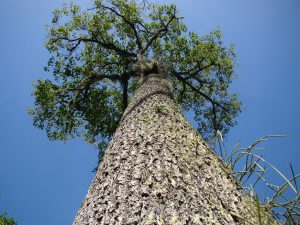
The Brazil Nut Tree – Bertholletia Excelsa – is enormous, the height of 14-story buildings. These trees channel up to 260 gallons of water each day from soil to sky, through their roots, up their trunks, and out through their leaves. They cause the rainforest to rain. The Amazon rainforest covers eight countries and its trees pump massive amounts of water into the atmosphere. At times, there is more water in the air above the Amazon rainforest than there is water in the 4,000-mile Amazon River. The Brazil Nut Tree is threatened by soy farmers, cattle ranchers, and miners destroying the forests.
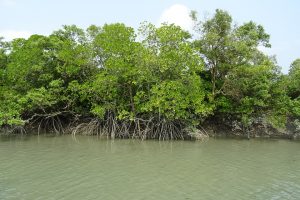
A second super tree is the Indonesian Stilt Mangrove – Rhizophora – that lives in the tides. Its roots are rinsed daily by briny water. Indonesia has 23% of the world’s mangroves, an area the size of Belgium. In addition to coastal protection, habitat, protection for small fish, these mangroves absorb 5 – 10 times as much CO2 per acre as rainforests. As their leaves fall, get caught in wet soil, they are trapped and form blue carbon… underground storage of carbon up to 10 feet deep. Given this unusually productive carbon capture, the preservation and restoration of mangroves is considered a promising “negative emissions technology” (NET).
The third tree featured is the Afrormosia – the African Teak Tree — that lives in the Congo Basin, the world’s second largest rainforest covering six countries. These trees are huge carbon sinks, grow rapidly, while serving as the forests’ caretakers. They provide food in the form of unripe seed pods for monkeys and birds and shade for other flora and fauna. Their bark is flame resistant. Given demand for their wood, for yachts and flooring in the United States, Europe, and China, described as an “insatiable appetite,” they’ve gone extinct in several countries.
Renewable Natural Gas 201
An esteemed colleague stomped on Renewable Natural Gas (RNG) the other day, insisting that the impacts of forming methane in our society far outweigh the benefits. Look at the global warming potential of methane, some 30 times that of CO2, and remember that pipelines leak, he stressed.
But what about the solar-hydrogen economy I ask? Isn’t RNG a bridge to that future? My friend was quite adamant: There is no reason to form the RNG production industry because it is fundamentally based on wasteful habits. Ideally, there will be no methane as organic materials are smartly reused without the anaerobic digestion that produces methane.
Let’s back up a bit. There are three primary sources of RNG:
- Anaerobic Digestion occurs in the absence of air in landfills, animal manure on farms, water resources reclamation plants, and food materials.
- Gasification produces RNG from agricultural residues, forestry and forest product resources, “energy crops,” and municipal solar wastes.
- Power to Gas (P2G) results from the production of hydrogen from electrolytic or photolytic processes that splits water using renewable energy resources, and the methanation of hydrogen to use in natural gas pipelines.
Sparking the debate about RNG is another acronym: CAFO for Concentrated Animal Feeding Operations. CAFOs are problematic in many ways that the Sierra Club articulated in a policy brief on methane digesters using manure. CAFOs are disastrous in many ways – diseases, antibiotics, growth hormones, waste run-off, mistreatment of animals, disruptions to community farming — so their fundamental operations are in the cross hairs. On a case-by-case basis, the Sierra Club sees merit in some instances for methane digesters on smaller farms.
In addition to digesters at CAFOs, there are digesters for aquaculture products, organic wastes, wastewater, food wastes, garden and lawn clippings, plant material, paper, cardboard, and wood. The methane is produced in the decomposition of organic materials. For farms, there are alternatives. Instead of collecting and centralizing manure production for anaerobic digestion, farmers can create compost through aerobic digestion (bacteria in the presence of oxygen that releases CO2, not methane), or in cases can spread manure on their fields providing enrichment to the soils without fermentation.
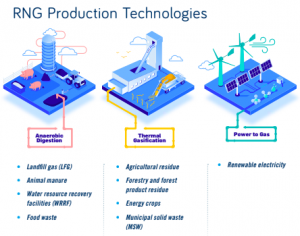
Clearly, given methane’s greenhouse gas intensity, and the fact that our society has landfills, it is better to collect methane emanating from landfills than to release landfill gases into the air. RNG collection that keeps methane out of the atmosphere is carbon negative…meaning that more CO2-equivalent gas is captured than is given off in combustion or fuel cell use of the methane. Gasification holds promise for a broad spectrum of organic materials. A pilot plant in Gothenburg Sweden effectively used forest residues to produce RNG. Municipal solid waste can be gasified to create fuel.
The Power to Grid concept utilizes “excess renewables,” using the infamous utility Duck Curve’s excesses rather than allowing the duck curve to thwart further development of wind and solar. The hydrogen fuel can be “bottled” and sold for vehicle fuel or can be injected in natural gas pipelines to a point, creating “hydrogen-rich” natural gas. But that has its limits at about 10% concentration. For widespread pipeline use, the gas distribution system and all end-use appliances would have to be converted for hydrogen.
The near-term pathway for P2G hydrogen is methanation so that the hydrogen gas can be mixed with geologic or renewable natural gas in the existing gas pipeline and distribution infrastructure. This is done using the Sabatier Reaction that was developed in 1897 by a Frenchman who won the Nobel Prize for his chemistry works. The process uses electrolysis to split water into oxygen and hydrogen. By adding CO2, methane is created. This process of methanation provides for synthetic natural gas that can be used readily in existing natural gas systems.
Until we radically transform our society and eliminate centralized waste streams, RNG has a role in our society and represents a positive step forward. The reputation of CAFOs ought not shadow other beneficial sources of RNG. Clearly, unless we abandon them, we must tighten our natural gas pipelines. While a bit complex, there are reasons to value this carbon negative fuel source as a piece of the puzzle on a pathway to a sustainable future. More to come on this.
47.1% Photovoltaic Efficiency
Researchers in the High Efficiency Crystalline Photovoltaic Group at the National Renewable Energy Laboratory (NREL) in Golden, Colorado have created a six-junction photovoltaic cell that achieved 47.1% efficiency.
For years, solar panels have been delivering power, converting 15 – 17% of the sunlight’s potential into electricity. High-quality/higher cost cells have reached as high as 22-23% efficiency.
NREL’s recent and dramatic efficiency gain – doubling the industry’s best practices — was possible thanks to the use of special “111-V materials,” so called because of their place on the periodic table.
The record-breaking 47.1% efficiency value was measured under concentrated illumination. At 1 Sun of intensity (1 kW/square meter) the multijunction solar cells converted 39.2% of the light into current. Each of the cells’ six junctions – “photo-active layers” – is specially designed to capture light from a specific part of the solar spectrum. In all, 140 layers of materials were used to support this record-breaking performance.
Big Solar and Qatar’s Record Low Price

WikiSolar reports that large-scale solar experienced a record year in 2019 after a dip in 2017 – 2018. In 2019, 45 gigawatts (GW) was installed worldwide, bringing the cumulative total to 220 GW. The top three countries – China (69 GW), the United States (40 GW), and India (30 GW) were far ahead of the rest of the pack. United Kingdom, Japan, Germany, Spain, Australia, Mexico and France round out the top ten countries in terms of cumulative solar capacity. The number one installer in 2019 was the United States with 9.6 GW of new solar. But read on to see which country is the least-cost installer in the world!
Qatar General Electricity and Water Corporation (Kahramaa) announced that its request for solar proposals and its selection process was closed last week for a 800 MW photovoltaic project. The final award was based on a power purchase price of 0.0571 Qatari Riyal per kWh – that’s $0.0157 per kWh USD for 25 years, representing the lowest cost large-scale renewable energy award ever known.
The project will be owned 60% by the Siraj Energy, a joint venture founded by Qatar Petroleum and Kahramaa, and 40% by a consortium made up of French oil giant Total and Japanese Marubeni Corporation. They undercut the previous record-holding low price when Akuo Energy contracted for 1.67 cent per solar kWh for 150 MW in Portugal. The Saudi Arabian energy group ACWA Power reportedly came very close to that record offer with its pricing for the fifth phase of the Mohammed bin Rashid Al Maktoum solar park in Dubai.
Sweden is Coal Free
On April 16 Sweden announced that it has officially closed its last coal-fired power plant two years early of its 2022 pledge and joined Belgium (2016) and Austria (2020) as the trio of European countries that are now coal-free. The Swedish government’s announcement followed Stockholm Energi’s decision to permanently close of its last coal plant. The utility had shuttered its last boiler there given the mild winter. The City of Stockholm has a goal of carbon neutrality by 2040. The coal plant’s closure will halve its utility emissions from ~900,000 tonnes to 441,000 tonnes.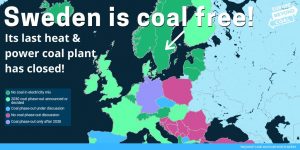
Six other European countries have pledged to eliminate coal-fired power production by 2025: France, Slovakia, Portugal, United Kingdom, Ireland, and Italy. Five more countries will be coal free by 2030. German, the world’s number one producer of brown lignite coal, pledged to do so by 2038.
Meanwhile, big progress to going coal-free is being made stateside: Partly due to the pandemic, renewables are producing more power than coal for the first time ever. That’s unthinkable. A decade ago coal was the nation’s baseload source of power providing about 50% of our country’s requirement. In the first 4.5 months of 2020, America’s wind turbines, solar panels, and hydroelectric dams produced more electricity than coal on 90 separate days, shattering last year’s 38-day count. On May 1 in Texas, wind produced three times as much power as coal.
In the United States, wind prices are down 40% in a decade; solar 80%. Fracking for natural gas has cut gas costs, making coal all the more uncompetitive in the markets. American utilities have closed hundreds of coal plants this past decade. Coal is expected to drop 25% this year, providing 19% of the nation’s power in 2020, less than renewables.
California to Mandate Electric Trucks
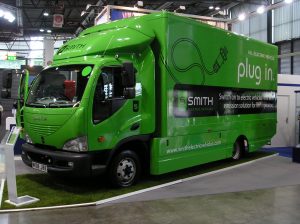 California’s policy makers are developing a first-of-its-kind plan to phase-in electric trucks. The rules cover trucks from full-sized pickups to huge semis and everything in between. The California Air Resources Board goal is for 100% of trucks to be zero emission by 2045. CARB ruled in 2018 that public transit agencies achieve 100% zero emission fleets by 2040. The final draft of its Advanced Clean Trucks Standard that is expected to be adopted later this year will be the first in the country.
California’s policy makers are developing a first-of-its-kind plan to phase-in electric trucks. The rules cover trucks from full-sized pickups to huge semis and everything in between. The California Air Resources Board goal is for 100% of trucks to be zero emission by 2045. CARB ruled in 2018 that public transit agencies achieve 100% zero emission fleets by 2040. The final draft of its Advanced Clean Trucks Standard that is expected to be adopted later this year will be the first in the country.
Truck manufacturers will have to meet production goals for electric trucks. They will need to have produced 100,000 electric trucks by 2030 out of 1.8 million trucks projected to be on the road, and to have produced 300,000 electric trucks by 2035 out of the 1.9 million trucks anticipated. These goals double the goals in a previous draft of the plan. The final draft also calls for 4,000 electric trucks by 2024, moved up from 2027, out of ~75,000 trucks per year in total sales. Class 2b pickups – such as the Ford 250 — are now included in the standard for 2024 rather than being exempt until 2027 as was stated in the prior draft.
The CARB policy will apply to only those companies selling more than 500 trucks annually. These include Daimler (which makes Freightliner, Thomas Built Buses, Western Star), Paccar (Kenworth, Peterbilt), Navistar (International, IC Bus), Ford, GM (Chevrolet, GMC), Fiat Chrysler (Dodge), Nissan, Isuzu, Toyota (Hino), and Volvo Group. The marginal cost for an electric tractor trailer could be $100,000.
Union of Concerned Scientists notes that trucks make up about 10% of all vehicles nationally. The 28 million trucks and buses recorded in 2019 are responsible for 28% of the total carbon emissions in the transportation sector. Heavy-duty vehicles are responsible for 45% of nitrous oxides and 57% of Particular Matter 2.5. According to Electrek, there are now more than 75 electric trucks and buses available from 27 manufacturers. Finally, there is precedence and hope: California’s goal for zero emission cars is 5,000,000 by 2030 and so far we’re at 700,000.
Laundry to Landscape
This caught my eye. A neighboring utility is offering no-cost installations of systems to recover greywater from laundry machines. The systems are simple and pipe the water into landscapes. They call it L2L: Laundry to Landscape. If you live in Pasadena, you can call and have a system at no cost, just fill in a direct-install greywater application, get an onsite survey of property. There’s no permit required for the DIY – do it yourself – installation.
Art Ludwig of Oasis Design originated the Laundry to Landscape Greywater System and published it unpatented into the public domain in 2008 for the good of all. Simple solutions, no pumps, just gravity, no filters that clog. Easiest way to use it, pipe it outside to water ornamental plants. The system can also be used for vegetables as long as the water does not touch the edible parts of the plant. Of course, it is essential to use plant-friendly products without lots of salt, boron, or chlorine bleach. Due to the inherent simplicity and low cost, these systems have been adopted, accommodated in building codes, the subject of government rebates, workshops and government training. Oasis cites Greywater Action as the premier provider of workshops on Laundry to Landscape systems.
The most basic form of greywater system is Laundry to Landscape, typically moving less than 250 gallons per day. Greywater comes from showers, bathtubs, washing machines, and bathroom sinks. Wastewater from toilets, kitchen sinks, and dishwashers is kept separate and suited for the sewer. Greywater Action Group, based in Berkeley, California, notes that, “Greywater may contain traces of dirt, food, grease, hair, and certain household cleaning products. While greywater may look dirty, it is a safe and even beneficial source of irrigation water in a yard. Keep in mind that if greywater is released into rivers, lakes, or estuaries, its nutrients become pollutants, but to plants they are valuable fertilizer.”
Appointment News
Ted Flanigan has been appointed to the Glendale Water and Power Commission. Glendale Water and Power is one of California’s municipal utilities, 46 serve water, 44 serve electricity. GWP serves Glendale’s 206,283 residents with sales of 7.6 billion gallons of water and 1,490 GWh of electricity each year. Its peak electric demand is 332 MW. Its service territory covers 31 square miles. The Commission’s role is to advise the Glendale City Council on the utility’s issues and activities. Commissioners serve four-year terms.
